

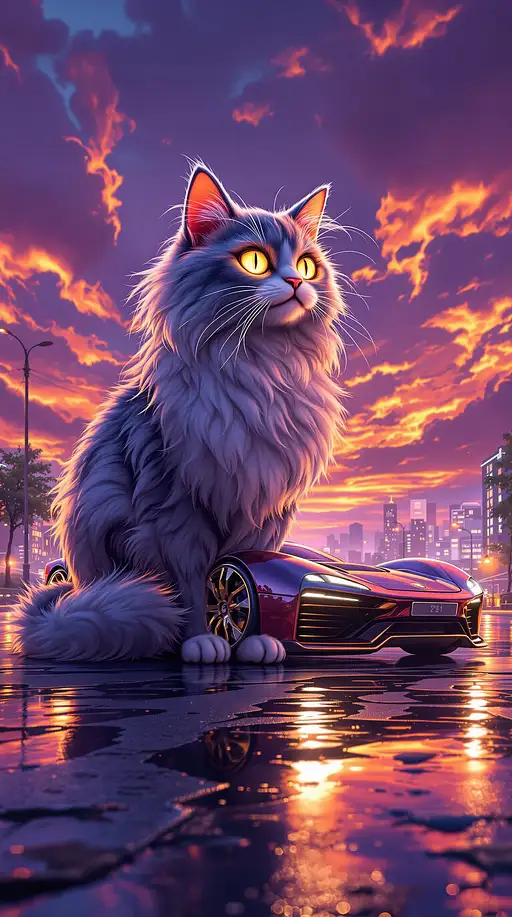
9 months ago
A unique hybrid creature merging the elegance of an Angora cat with the sleek design of a Porsche 911. The hybrid features a feline body with luxurious, flowing fur seamlessly integrated with aerodynamic car elements, such as glossy metallic textures, curved panels, and glowing headlights as eyes. The paws resemble finely engineered wheels or mechanical components, maintaining a balance between organic and automotive aesthetics. The background is a vibrant animated landscape at dusk, with a dramatic purple sky swirling with clouds, vivid orange sunset hues, and intricate city lights reflecting on wet streets. The dynamic perspective emphasizes the horizon, depicted in a digital painting style with rich colors and fluid brushstrokes, evoking a sense of wonder and tranquility inspired by Makoto Shinkai.

5 months ago
Create a meticulously staged cinematic scene with rigid symmetry and frontal, low-angle framing, emphasizing a diagonal composition (45-degree tilt) where all elements align along a single dynamic axis. Color Grading: 60% Dominant: Soft, powdery pastel pinks (Pantone 12-1109 TPX "Marshmallow") saturating the sky, snow, and TV casing. 30% Secondary: Frosted teal blues (HEX #6ECEDA) in the glacial lake, aurora, and TV screen static. 10% Accent: Mustard-yellow (Pantone 15-0950 TPX "Golden Glow") in the aurora streaks, wool tufts, and corroded metal knobs. TV Design: A 1950s Bakelite TV (matte eggshell plastic with hairline cracks) tilted diagonally (top-left corner at 10 o’clock, bottom-right submerged at 4 o’clock). Crack: A jagged diagonal fissure (2cm wide) splits the screen from top-left to bottom-right, leaking viscous, neon-bright color bar pigment (RGB values: pink #FF9EB5, teal #5FDAC3, gold #FFD700) that pools into the water below. Materials: Body: Faux-weathered plastic with chipped edges revealing rusted steel underlayers. Details: Three rotary knobs (tarnished brass, 4cm diameter) labeled "VOL," "TUNE," "POWER." Cables: Braided wool cords (undyed cream yarn, 3cm thickness) coiled around the TV’s base, fraying at the ends. Screen Imagery: Static Overlay: A 1953 RCA-style color bar test pattern (8 vertical bands) glitching every 2 seconds, causing the teal and pink bars to "melt" downward into liquid the word "Imagen-4" glitches on the screen Underlying Image: A faint, glowing topographical map (golden-yellow lines on indigo) dissolves into water that cascades from the screen’s crack, merging with the glacial lake. Environment: Glacial Lake: Semi-frozen water (translucent teal, 70% opacity) with jagged ice shards (20cm height) encircling the TV. Snowfall: Heavy, dense snowflakes (1cm diameter) falling at 45 degrees, accumulating on the TV’s top-left corner. Aurora Borealis: Three parallel bands (pink #FFB3D1, teal #7FE5E5, gold #FFE44D) in smooth sine waves, 15° tilt, 80% opacity. Sky: Ultra-high-contrast starfield (ISO 51200 noise pattern) with 2,000 visible stars (randomized 2-4px white dots). Lighting & Effects: Key Light: A frontal, low-orange sodium vapor lamp (3200K) casting sharp diagonal shadows (20° angle) from the TV onto the ice. Bloom: Halation around the aurora and screen, radius 15px, intensity 70%. Textures: Film Grain: 35mm Kodak Vision3 250D overlay (gritty, high-detail). Lens Defects: Two hairline scratches (1px width) at 15° and 75° angles, plus hexagonal lens flare (60% opacity) from the aurora. Physics & Motion: Water: Viscous fluid dynamics—the leaking color bars swirl in 5cm eddies, blending with the glacial lake. Wool: Submerged yarn floats upward in 10cm tufts, swaying at 0.5Hz frequency. Result: A hyper-detailed, reference-free scene that implicitly channels Wes Anderson’s aesthetic through obsessive symmetry, retro-kitsch materials, and a strict 60/30/10 pastel hierarchy—no director named, all style embedded in granular technical specs.

5 months ago
"Create a meticulously staged cinematic scene with rigid symmetry and frontal, low-angle framing, emphasizing a diagonal composition (45-degree tilt) where all elements align along a single dynamic axis. Color Grading: 60% Dominant: Soft, powdery pastel pinks (Pantone 12-1109 TPX "Marshmallow") saturating the sky, snow, and TV casing. 30% Secondary: Frosted teal blues (HEX #6ECEDA) in the glacial lake, aurora, and TV screen static. 10% Accent: Mustard-yellow (Pantone 15-0950 TPX "Golden Glow") in the aurora streaks, wool tufts, and corroded metal knobs. TV Design: A 1950s Bakelite TV (matte eggshell plastic with hairline cracks) tilted diagonally (top-left corner at 10 o’clock, bottom-right submerged at 4 o’clock). Crack: A jagged diagonal fissure (2cm wide) splits the screen from top-left to bottom-right, leaking viscous, neon-bright color bar pigment (RGB values: pink #FF9EB5, teal #5FDAC3, gold #FFD700) that pools into the water below. Materials: Body: Faux-weathered plastic with chipped edges revealing rusted steel underlayers. Details: Three rotary knobs (tarnished brass, 4cm diameter) labeled "VOL," "TUNE," "POWER." Cables: Braided wool cords (undyed cream yarn, 3cm thickness) coiled around the TV’s base, fraying at the ends. Screen Imagery: Static Overlay: A 1953 RCA-style color bar test pattern (8 vertical bands) glitching every 2 seconds, causing the teal and pink bars to "melt" downward into liquid with the word "Prompthero" barely visible on it. Underlying Image: A faint, glowing topographical map (golden-yellow lines on indigo) dissolves into water that cascades from the screen’s crack, merging with the glacial lake. Environment: Glacial Lake: Semi-frozen water (translucent teal, 70% opacity) with jagged ice shards (20cm height) encircling the TV. Snowfall: Heavy, dense snowflakes (1cm diameter) falling at 45 degrees, accumulating on the TV’s top-left corner. Aurora Borealis: Three parallel bands (pink #FFB3D1, teal #7FE5E5, gold #FFE44D) in smooth sine waves, 15° tilt, 80% opacity. Sky: Ultra-high-contrast starfield (ISO 51200 noise pattern) with 2,000 visible stars (randomized 2-4px white dots). Lighting & Effects: Key Light: A frontal, low-orange sodium vapor lamp (3200K) casting sharp diagonal shadows (20° angle) from the TV onto the ice. Bloom: Halation around the aurora and screen, radius 15px, intensity 70%. Textures: Film Grain: 35mm Kodak Vision3 250D overlay (gritty, high-detail). Lens Defects: Two hairline scratches (1px width) at 15° and 75° angles, plus hexagonal lens flare (60% opacity) from the aurora. Physics & Motion: Water: Viscous fluid dynamics—the leaking color bars swirl in 5cm eddies, blending with the glacial lake. Wool: Submerged yarn floats upward in 10cm tufts, swaying at 0.5Hz frequency. Result: A hyper-detailed, reference-free scene that implicitly channels Wes Anderson’s aesthetic through obsessive symmetry, retro-kitsch materials, and a strict 60/30/10 pastel hierarchy—no director named, all style embedded in granular technical specs.

5 months ago
Vertical composition (1024x1792). A soul's ascent from Earth to Heaven. Top third: Heaven in the style of Gustav Klimt â radiant gold leaf, mosaic textures, swirling divine light, abstract ethereal forms. Colors: gold, opalescent white, celestial blue, warm ochre. Atmosphere: luminous, sacred, full of spiritual energy. Lower two-thirds: Earth in the style of Käthe Kollwitz â expressive, raw linework, depicting human struggle and resilience. Muted tones: charcoal gray, deep brown, desaturated blue. Mood: somber, grounded, emotionally powerful. Central figure: Rising soul. Lower body in Kollwitz style, worn clothing, lines of experience. Upper body transitions into Klimtâs ornate golden patterns, merging into the light. Middle transition: Smooth stylistic shift from earthâs hardship to divine beauty. Symbolizes release and transformation. Overall feel: Emotional, symbolic, reflective. A powerful visual of spiritual journey, inner strength, and transcendence.âââ

6 months ago
A captivating acrylic painting of an abstract female figure adorned in a breathtaking dress, crafted from flowing beams of colored light and translucent materials. The dress has an ethereal and fluid silhouette, with its dynamic light patterns accentuating the figure's otherworldly presence. Atop her head, a delicate halo of light entwines with the luminous fabric, emanating a sense of divine and abstract beauty. The background is filled with vibrant, swirling gases and dynamic light patterns, creating a cosmic tapestry of color and movement. This unique piece of art merges elements of graffiti, conceptual art, fashion, 3D render, and ukiyo-e, making it a truly unique and mesmerizing masterpiece with a vivid and hd quality.

9 months ago
A surreal and ethereal digital painting of two faces one male, one female emerging from swirling, colorful energy, seamlessly blending into a heart shape. The woman on the left glows with fiery warm tones of orange, red, and gold, radiating passion and warmth. The man on the right is enveloped in cooler hues of purple, blue, and magenta, exuding a sense of mystery and tranquility. Their faces are nearly touching, eyes closed, as if in a deep, intimate connection. Their flowing, wispy hair extends outward, merging into the heart’s shape, giving the image a dreamlike, otherworldly feel. The background is a soft gradient of blended colors, fading into misty clouds, enhancing the ethereal and emotional depth of the scene. Small glowing embers and delicate floating petals drift around the composition, adding a magical touch. The contrast between warm and cool tones creates a powerful visual and emotional balance, symbolizing love, unity, and harmony. **Style & Quality:** ultra-detailed, surreal fantasy, painterly aesthetic, vibrant colors, soft glow **Camera & Composition:** mid-range shot, straight-on angle, symmetrical framing **Mood & Atmosphere:** romantic, mystical, emotional, symbolic **Rendering Keywords:** high-definition, 4K, ethereal art, fantasy surrealism, glowing effects, dreamlike aesthetic
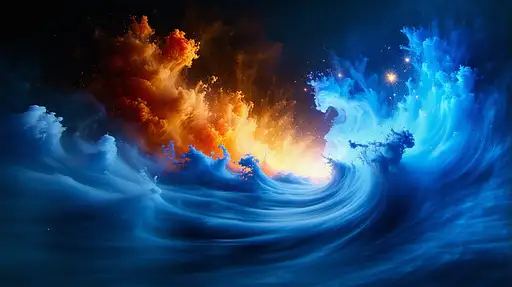
8 months ago
A dynamic clash of colors unfolds as swirling formations of deep blue and vibrant orange seem to collide at the center, suggesting a cosmic battle between light and darkness. The blue side, radiating a cool, calming glow, merges fluidly with ethereal white bursts, while the orange emanates warmth and energy, punctuated by bright golden highlights that flicker like stars. The abstract composition conveys a sense of movement, with the swirling textures and gradients drawing the viewer toward the tension of this duality. This image evokes themes of contrast, balance, and the interplay of elemental forces, creating a captivating visual narrative in a surreal style.
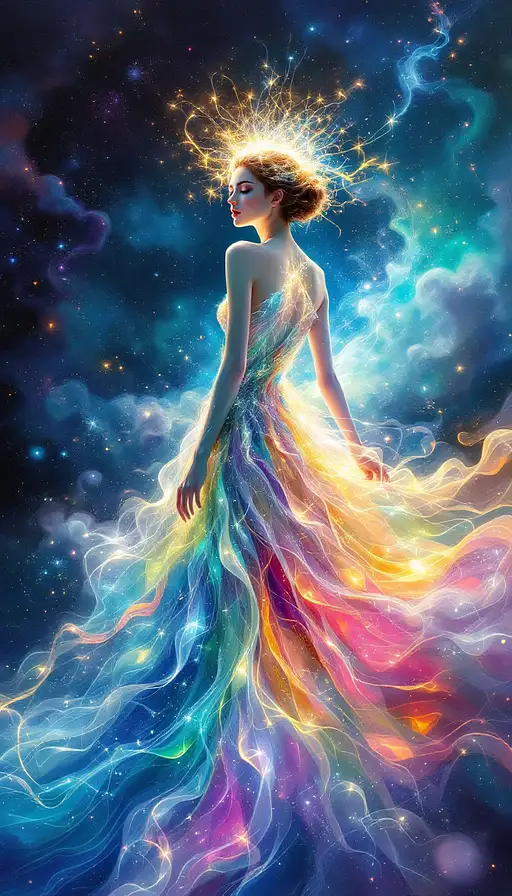
7 months ago
A captivating acrylic painting of an abstract female figure adorned in a breathtaking dress, crafted from flowing beams of colored light and translucent materials. The dress has an ethereal and fluid silhouette, with its dynamic light patterns accentuating the figure's otherworldly presence. Atop her head, a delicate halo of light entwines with the luminous fabric, emanating a sense of divine and abstract beauty. The background is filled with vibrant, swirling gases and dynamic light patterns, creating a cosmic tapestry of color and movement. This unique piece of art merges elements of graffiti, conceptual art, fashion, 3D render, and ukiyo-e, making it a truly unique and mesmerizing masterpiece with a vivid and hd quality.
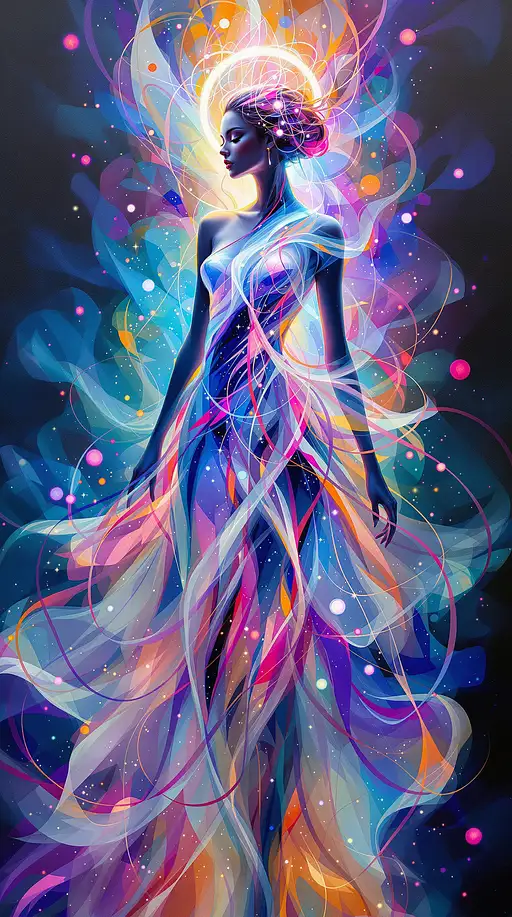
7 months ago
A captivating acrylic painting of an abstract female figure adorned in a breathtaking dress, crafted from flowing beams of colored light and translucent materials. The dress has an ethereal and fluid silhouette, with its dynamic light patterns accentuating the figure's otherworldly presence. Atop her head, a delicate halo of light entwines with the luminous fabric, emanating a sense of divine and abstract beauty. The background is filled with vibrant, swirling gases and dynamic light patterns, creating a cosmic tapestry of color and movement. This unique piece of art merges elements of graffiti, conceptual art, fashion, 3D render, and ukiyo-e, making it a truly unique and mesmerizing masterpiece with a vivid and hd quality.

7 months ago
An awe-inspiring oil painting of a dynamic double exposure composition, merging the intense focus of a rugby player with the electrifying energy of a packed stadium. The rugby player, captured mid-action with powerful muscles and a look of determination, is the central focus. His body is both a canvas and a vessel for the vibrant, chaotic energy of the arena that surrounds him. The crowded stadium is interwoven with his figure, where the masses of fans, their hands raised in excitement, blend seamlessly into the contours of his athletic form. The roaring crowd appears to swirl around his legs and arms, almost as if they are part of his very movement, amplifying the power and emotion of the moment. The bright floodlights of the stadium cast dramatic shadows, highlighting the intensity in both the player's face and the spectators’ expressions. In the background, hints of the field’s green turf and the towering stands fade in and out, giving the impression of an immense, almost overwhelming energy. The brushwork should evoke movement, both in the player’s swift action and in the crowd’s passionate cheer, with the crowd’s vibrant colors gradually dissolving into the player's silhouette. The fusion of these elements should convey the intense, symbiotic relationship between the player and the arena, showing how one fuels the other. The painting should evoke raw emotion, strength, and the rush of a critical moment in a rugby match, capturing the spirit of sportsmanship, determination, and the collective energy of a championship showdown

3 months ago
A young girl in a bright yellow coat gazes at her reflection in an ornate mirror, her hand reaching tentatively toward the glass. The surreal background swirls with vibrant pink and blue organic shapes as golden frames float around glowing lanterns. Gradually, fiery chaos from the mirror's reflection spills into the calm foreground, merging swirling flames with the dreamlike colors. The camera remains stationary, capturing the magical contrast between tranquility and turmoil through rich textures and luminous details., hyper realistic, super detailed, pastel colors, --ar 24:36 --q 2 --s 750
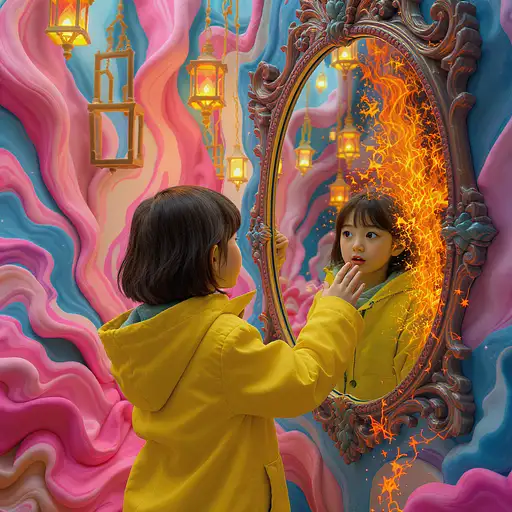
3 months ago
A young girl, short brown hair, Asian, in a bright yellow coat gazes at her reflection in an ornate mirror, her hand reaching tentatively toward the glass. The surreal background swirls with vibrant pink and blue organic shapes as golden frames float around glowing lanterns. Gradually, fiery chaos from the mirror's reflection spills into the calm foreground, merging swirling flames with the dreamlike colors. The camera remains stationary, capturing the magical contrast between tranquility and turmoil through rich textures and luminous details, like clay, hyper realistic, super detailed, pastel colors, --ar 24:36 --q 2 --s 750

3 months ago
A young girl in a bright yellow coat gazes at her reflection in an ornate mirror, her hand reaching tentatively toward the glass. The surreal background swirls with vibrant pink and blue organic shapes as golden frames float around glowing lanterns. Gradually, fiery chaos from the mirror's reflection spills into the calm foreground, merging swirling flames with the dreamlike colors. The camera remains stationary, capturing the magical contrast between tranquility and turmoil through rich textures and luminous details, like clay, hyper realistic, super detailed, pastel colors, --ar 24:36 --q 2 --s 750

5 months ago
A dynamic, chaotic scene capturing the essence of a wild ride â swirling colors, explosive energy, and surreal shapes merging into a vibrant storm of motion. An electric bike (e-bike) speeds through the whirlwind, its neon lights cutting through the chaos. The style blends abstract expressionism with cyberpunk neon glows and glitch art distortions. Elements like speeding vehicles, wild animals, and bursts of nature entwine in a kaleidoscopic whirlwind, evoking excitement, unpredictability, and raw emotion

3 months ago
Digital dynamic angle artwork featuring zodiac two gemini ethereal female figures each other in a cosmic setting. The style is surreal and dreamlike, with a focus on flowing lines and celestial elements. Both figures ghostly pale skin and are adorned with intricate, luminous patterns that resemble constellations. Their hair appears to merge with the surrounding colorful nebula-like swirls, creating a sense of unity with the universe. The background is a deep, starry expanse, with bright stars and glowing wisps of light that enhance the mystical atmosphere. The overall composition is symmetrical, with the figures positioned centrally, creating a harmonious balance between them. The use of light and shadow adds depth and dimension, emphasizing the otherworldly theme of the artwork.

2 months ago
A iranian woman's form glitches and replicates in a surreal Tehran kitchen. The walls melt into Qajar-era lacquer art, with traditional patterns (gol-o-morgh) swirling like liquid. Style: a digital glitch artifact merged with traditional Persian miniature painting. Deep, saturated colors. Dynamic camera circling the subject, slow zoom, ethereal atmosphere, high contrast. 4K, 24fps, surreal transformation, otherworldly.

1 month ago
classic art noir vintage print with high-tech futuristic elements. Image is a digital artwork featuring a stylized, futuristic depiction, cybernetic digitized glitch image, discrete faint outline of hidden art noir decor within a busy teeming digital silhouette of abstract wildflowers and trees. The image, an Art noir photograph, captures the moment of an exotic blooming encounter in an futuristic subway. Their organic flowers seem to merge, with swirling patterns of neon light and fractured digital coded darkness intertwining between them. crisp fluid lines and organic shapes colors enhance the dreamlike art noir quality of the scene, while intricate details draw the viewer deeper into the mesmerizing trance of this captivating visual narrative. This digital anime art noir painting captures a sense of otherworldly enchantment, with every pixel meticulously rendered to convey a sense of depth and movement. The cyborg flowers gleam with an enigmatic sparkle, hinting at untold power and ancient wisdom hidden behind the enigmatic façade of the petals. The contrast between the darkness and the shimmering gold of their ornate crystalline petals and leaves creates a mesmerizing visual feast for the eyes, drawing the viewer into a realm of magic and mystery. of stylish vintage and futuristic techno, paneling on the subway walls are a neon contrast to the black and white of the floral display. glitched digital neon background
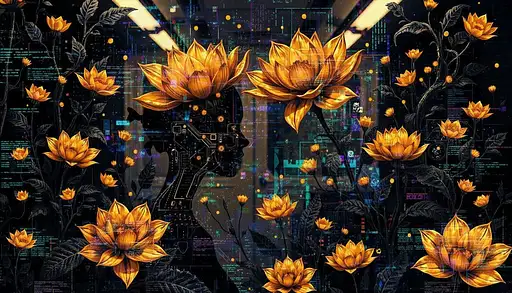
1 month ago
classic art noir vintage print with high-tech futuristic elements. Image is a digital artwork featuring a stylized, futuristic depiction, cybernetic digitized glitch image, discrete faint outline of hidden art noir decor within a busy teeming digital silhouette of abstract wildflowers and trees. The image, an Art noir photograph, captures the moment of an exotic blooming encounter in an futuristic subway. Their organic flowers seem to merge, with swirling patterns of neon light and fractured digital coded darkness intertwining between them. crisp fluid lines and organic shapes colors enhance the dreamlike art noir quality of the scene, while intricate details draw the viewer deeper into the mesmerizing trance of this captivating visual narrative. This digital anime art noir painting captures a sense of otherworldly enchantment, with every pixel meticulously rendered to convey a sense of depth and movement. The cyborg flowers gleam with an enigmatic sparkle, hinting at untold power and ancient wisdom hidden behind the enigmatic façade of the petals. The contrast between the darkness and the shimmering gold of their ornate crystalline petals and leaves creates a mesmerizing visual feast for the eyes, drawing the viewer into a realm of magic and mystery. of stylish vintage and futuristic techno, paneling on the subway walls are a neon contrast to the black and white of the floral display. glitched digital neon background

1 month ago
classic art noir vintage print with high-tech futuristic elements. Image is a digital artwork featuring a stylized, futuristic depiction, cybernetic digitized glitch image, discrete faint outline of hidden art noir decor within a busy teeming digital silhouette of abstract wildflowers and trees. The image, an Art noir photograph, captures the moment of an exotic blooming encounter in an futuristic subway. Their organic flowers seem to merge, with swirling patterns of neon light and fractured digital coded darkness intertwining between them. crisp fluid lines and organic shapes colors enhance the dreamlike art noir quality of the scene, while intricate details draw the viewer deeper into the mesmerizing trance of this captivating visual narrative. This digital anime art noir painting captures a sense of otherworldly enchantment, with every pixel meticulously rendered to convey a sense of depth and movement. The cyborg flowers gleam with an enigmatic sparkle, hinting at untold power and ancient wisdom hidden behind the enigmatic façade of the petals. The contrast between the darkness and the shimmering gold of their ornate crystalline petals and leaves creates a mesmerizing visual feast for the eyes, drawing the viewer into a realm of magic and mystery. of stylish vintage and futuristic techno, paneling on the subway walls are a neon contrast to the black and white of the floral display. glitched digital neon background
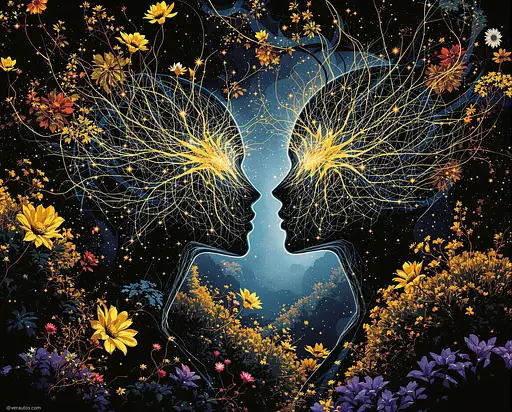
1 month ago
classic art noir vintage print with high-tech futuristic elements. Image is a digital artwork featuring a stylized, futuristic depiction, cybernetic digitized glitch image, discrete faint outline of hidden art noir decor within a busy teeming digital silhouette of abstract wildflowers and trees. The image, an Art noir photograph, captures the moment of an exotic blooming encounter in an futuristic subway. Their organic flowers seem to merge, with swirling patterns of neon light and fractured digital coded darkness intertwining between them. crisp fluid lines and organic shapes colors enhance the dreamlike art noir quality of the scene, while intricate details draw the viewer deeper into the mesmerizing trance of this captivating visual narrative. This digital anime art noir painting captures a sense of otherworldly enchantment, with every pixel meticulously rendered to convey a sense of depth and movement. The cyborg flowers gleam with an enigmatic sparkle, hinting at untold power and ancient wisdom hidden behind the enigmatic façade of the petals. The contrast between the darkness and the shimmering gold of their ornate crystalline petals and leaves creates a mesmerizing visual feast for the eyes, drawing the viewer into a realm of magic and mystery. of stylish vintage and futuristic techno, paneling on the subway walls are a neon contrast to the black and white of the floral display. glitched digital neon background
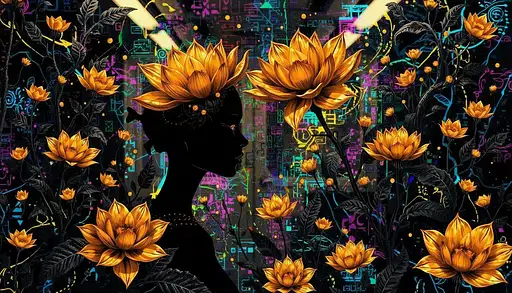
1 month ago
classic art noir vintage print with high-tech futuristic elements. Image is a digital artwork featuring a stylized, futuristic depiction, cybernetic digitized glitch image, discrete faint outline of hidden art noir decor within a busy teeming digital silhouette of abstract wildflowers and trees. The image, an Art noir photograph, captures the moment of an exotic blooming encounter in an futuristic subway. Their organic flowers seem to merge, with swirling patterns of neon light and fractured digital coded darkness intertwining between them. crisp fluid lines and organic shapes colors enhance the dreamlike art noir quality of the scene, while intricate details draw the viewer deeper into the mesmerizing trance of this captivating visual narrative. This digital anime art noir painting captures a sense of otherworldly enchantment, with every pixel meticulously rendered to convey a sense of depth and movement. The cyborg flowers gleam with an enigmatic sparkle, hinting at untold power and ancient wisdom hidden behind the enigmatic façade of the petals. The contrast between the darkness and the shimmering gold of their ornate crystalline petals and leaves creates a mesmerizing visual feast for the eyes, drawing the viewer into a realm of magic and mystery. of stylish vintage and futuristic techno, paneling on the subway walls are a neon contrast to the black and white of the floral display. glitched digital neon background

1 month ago
classic art noir vintage print with high-tech futuristic elements. Image is a digital artwork featuring a stylized, futuristic depiction, cybernetic digitized glitch image, discrete faint outline of hidden art noir decor within a busy teeming digital silhouette of abstract wildflowers and trees. The image, an Art noir photograph, captures the moment of an exotic blooming encounter in an futuristic subway. Their organic flowers seem to merge, with swirling patterns of neon light and fractured digital coded darkness intertwining between them. crisp fluid lines and organic shapes colors enhance the dreamlike art noir quality of the scene, while intricate details draw the viewer deeper into the mesmerizing trance of this captivating visual narrative. This digital anime art noir painting captures a sense of otherworldly enchantment, with every pixel meticulously rendered to convey a sense of depth and movement. The cyborg flowers gleam with an enigmatic sparkle, hinting at untold power and ancient wisdom hidden behind the enigmatic façade of the petals. The contrast between the darkness and the shimmering gold of their ornate crystalline petals and leaves creates a mesmerizing visual feast for the eyes, drawing the viewer into a realm of magic and mystery. of stylish vintage and futuristic techno, paneling on the subway walls are a neon contrast to the black and white of the floral display. glitched digital neon background
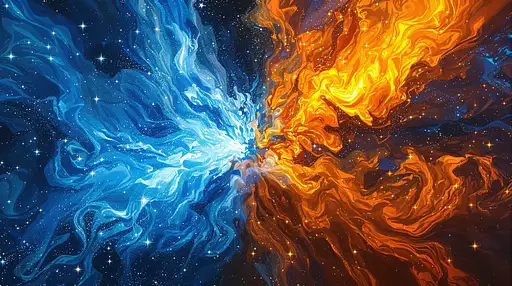
8 months ago
A dynamic clash of colors unfolds as swirling formations of deep blue and vibrant orange seem to collide at the center, suggesting a cosmic battle between light and darkness. The blue side, radiating a cool, calming glow, merges fluidly with ethereal white bursts, while the orange emanates warmth and energy, punctuated by bright golden highlights that flicker like stars. The abstract composition conveys a sense of movement, with the swirling textures and gradients drawing the viewer toward the tension of this duality. This image evokes themes of contrast, balance, and the interplay of elemental forces, creating a captivating visual narrative in a surreal style.
